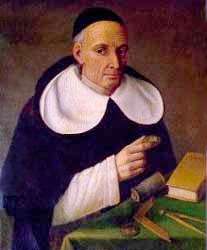Giovanni Battista Audiffredi
| Giovanni Battista Audiffredi | |
|---|---|
 | |
| Born |
2 February 1714 Saorge, France |
| Died |
4 July 1794 (aged 80) Rome, Italy |
| Nationality | Italian |
| Fields | Astronomy |
Giovanni Battista Audiffredi (2 February 1714 – 4 July 1794) was an Italian Dominican scholar and scientist.[1]
Life
Giovanni Battista Audiffredi entered the Dominican Order, and soon attracted attention by his taste for books and his talent for the exact sciences. After being occupied in various houses as professor and bibliographer, he was at length transferred to the College of St. Thomas at the Dominican convent of Santa Maria sopra Minerva, the future Pontifical University of St. Thomas Aquinas, Angelicum.[2] He was placed in charge (1765) of the Bibliotheca Casanatensis, founded in 1700 by Cardinal Girolamo Casanata.[1]
Works
Audiffredi published a bibliographical work in four folio, volumes entitled "Bibliotheca Casanatensis librorum typis impressorum, 1761–1790". The work remains unfinished, not proceeding beyond the letter L, and contains a list of his own publications. Similar works were the "Catalogus historico-criticus Romanarum editionum saeculi XV" (Rome, 1785, quarto), and the more extensively planned "Catalogus historico-criticus editionum Italicarum saeculi XV" (ibid., 1794,), which was to give an account of books printed in twenty-six Italian cities. Audiffredi did not live to complete the work. The first part, extending to the letter G, contains a short biography of the author introduced by the publisher.[1]
Audiffredi's position enabled him to become an expert antiquarian, and he found time to cultivate his mathematical talent and to devote himself to astronomy. He built a small observatory, and at intervals busied himself with observation. The eighteenth century was much occupied with the problem of solar parallax. In 1761 and 1769 the transit of Venus were observed, and Audiffredi contributed to the work in his publication, "Phaenomena coelestia observata—investigatio parallaxis solis. Exercitatio Dadei Ruffi" (anagram for Audiffredi). Alexandre Guy Pingré's subsequent discounting of Audifreddi's observations led to a scientific dispute.[3]
The predicted reappearance in the middle of the century of Halley's comet intensified scientific interest in cometic orbits. The epoch was favored with a number of brilliant objects of this kind, and that of 1769 distinguished itself by its great nucleus and by the tail which stretched over more than half the sky. Audiffredi took observations of the positions of the comet and published his results under the title, "Dimostrazione della stazione della cometa, 1769" (1770).
References
- 1 2 3 AUDIFFREDI, Giovanni Battista. Dizionario Biografico degli Italiani
- ↑ https://books.google.com/books?id=4hzzjm46TLsC&pg=PA165&lpg=PA165 Accessed 11 June 2014; http://www.newadvent.org/cathen/02069b.htm Accessed 12 June 2014
- ↑ Pigatto, Luisa (2005). "The 1761 transit of Venus dispute between Audiffredi and Pingré". Proceedings of the International Astronomical Union. 2004. Bibcode:2005tvnv.conf...74P. doi:10.1017/S1743921305001286.
 This article incorporates text from a publication now in the public domain: Herbermann, Charles, ed. (1907). "Audiffredi". Catholic Encyclopedia. 2. New York: Robert Appleton.
This article incorporates text from a publication now in the public domain: Herbermann, Charles, ed. (1907). "Audiffredi". Catholic Encyclopedia. 2. New York: Robert Appleton.